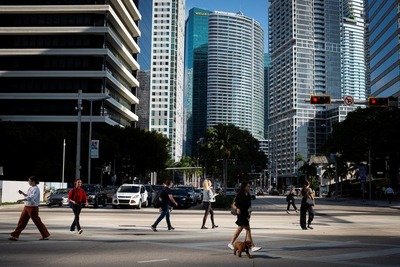US corporate profits hit record high before Trump's tariffs

The report from the
President
Business and consumer sentiment have sagged. The odds of a recession have risen, with the nation's trade partners also expected to retaliate through duties of their own.
"Profit margins are a leading recession indicator and, at least before the disruptions that will be caused by the tariff hikes, there was no reason to expect a recession in 2025," said
Profits from current production with inventory valuation and capital consumption adjustments jumped
The increase was the largest since the second quarter of 2021 and followed a decline of
A measure that is conceptually most similar to S&P 500 profits increased at a 6.7% pace after declining at a 0.3% pace in the July-September period. Overall, profits increased
Profit margins touched a record high as a share of gross domestic product, suggesting some scope for companies to absorb rising costs from tariffs. But most economists said it was unlikely that companies would willingly do so.
"Most businesses will likely try to pass costs on or cut expenses elsewhere to offset tariff effects," said
"The rub is that consumers are highly price-sensitive. While they're also acutely aware of tariffs and may be more willing to take price (increases) initially, they will grow more fatigued over time, denting firms' ability to pass costs continuously."
The Federal Reserve last week left interest rates unchanged, an acknowledgement of the uncertainty swirling around the economy.
Stocks on
PREEMPTIVE BUYING
Consumers, eager to avoid higher prices from imports, front-loaded purchases of goods last quarter, driving spending and keeping the economic expansion on track.
Gross domestic product increased at an upwardly revised 2.4% annualized rate, the BEA said in its third estimate of fourth-quarter GDP. Growth was previously estimated at a 2.3% pace. The economy grew at a 3.1% rate in the third quarter.
Strong profits boosted an alternative measure of economic growth. Gross domestic income grew at a 4.5% rate after rising at a 1.4% pace in the July-September period.
GDP and GDI generally should be equal, but in practice they differ as they are estimated using different and largely independent source data. Annual benchmark revisions tend to close the gap between GDP and GDI.
The average of GDP and GDI, also referred to as gross domestic output and considered a better measure of economic activity, increased at a 3.5% rate. Gross domestic output grew at a 2.2% pace in the third quarter.
Solid corporate margins are allowing companies to retain workers, supporting the labor market.
A separate report from the
But economic uncertainty is making firms increasingly hesitant to increase hiring, resulting in those who have lost their jobs experiencing difficulties finding new ones.
The number of people receiving benefits after an initial week of aid, a proxy for hiring, decreased 25,000 to a still-elevated seasonally adjusted 1.856 million during the week ending
Economists expect the Trump administration's aggressive trade policy and an ambitious campaign to drastically downsize the federal government through deep spending cuts and mass firings to shake labor market stability.
"If corporate profit margins compress because of a sudden weakening in the economy or higher input costs because of tariffs and the inability to pass them onto consumers, it could lay the groundwork for layoffs," said
There are signs that GDP growth has significantly slowed in the first quarter because of snowstorms and unseasonably cold weather as well as trade policy uncertainty.
A separate report from the
Most of the goods are being quickly snapped up by consumers, instead of accumulating in warehouses, which would normally blunt the impact on GDP. Goldman Sachs cut its first-quarter GDP estimate to a 1.0% rate from the 1.3% pace previously envisioned. The Atlanta Fed is forecasting GDP will contract at a 1.8% rate.
The divergence between the forecasts is due to imports of gold, mostly from
The BEA excludes most gold imports when calculating the imports component of GDP, Goldman Sachs said.
"While we don't anticipate an outright pullback in activity, we see the odds of a recession in the next 12 months at about 40%," said Lydia Boussour, senior economist at EY-Parthenon.
(Reporting by Lucia Mutikani; Editing by
(c) Reuters 2025. All rights reserved. Republication or redistribution of Reuters content, including by caching, framing or similar means, is expressly prohibited without the prior written consent of Reuters. Reuters and the Reuters sphere logo are registered trademarks and trademarks of the Reuters group of companies around the world.
Related News
-
PRESS DIGEST- New York Times business news - March 31
Reuters - 16 minutes ago
-
UK's Thames Water selects KKR as partner in equity process
Reuters - 16 minutes ago
-
Aston Martin says chairman to invest further $68 million in carmaker
Reuters - 18 minutes ago
-
Benzinga - 20 minutes ago
-
German import prices up 3.6% y/y in February
Reuters - 23 minutes ago
-
German retail sales rise more than expected in February
Reuters - 24 minutes ago
-
L'Oreal aims for around 5% growth in China market this year
Reuters - 26 minutes ago
-
Markets in Q1: Everything's been Trumped!
Reuters - 28 minutes ago






